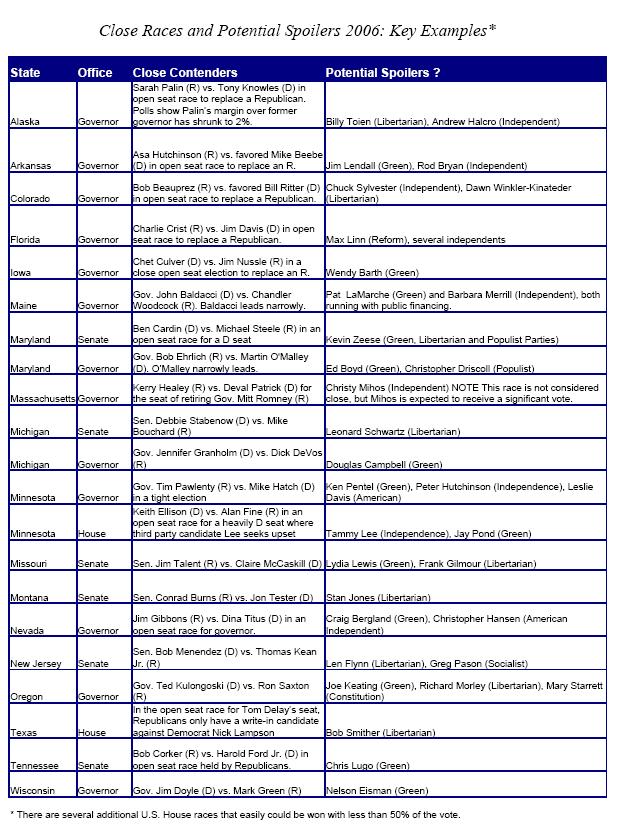Of Spoilers and Minority Rule
Where split votes in general and primary election could swing seats
We all remember controversies surrounding whether the 1992 presidential candidacy of Ross Perot and the 2000 candidacy of Ralph Nader swung those elections. It is less well-known how frequently third parties and independents can change the results of general elections for major congressional and statewide offices – nor how fractured results in primaries with big candidate fields can affect representation and parties’ general election odds. The 2006 mid-terms may remind us – and at the same time mark notable advances for instant runoff voting as a reform to ensure majority rule and accommodate increased voter choice. Below are profiles of how plurality voting rules are affecting elections in several states, a discussion of instant runoff voting ballot measures this year, and a listing of key races where winners may not win a majority in November.
Spotlighted November 7th Races
Texas Governor: Not Even Close to a Majority Winner?
The media bills this race as a wacky free-for-all battle to unseat incumbent Republican Rick Perry, who garnered just 38% in a recent poll. Democrat Chris Bell comes in at 22%, just ahead of independents Carole Keeton Strayhorn (a moderate Republican and mother of former White House spokesman Scott McClellan) at 21% and Kinky Friedman (an author seeking to capture Jesse Ventura’s populist mantle) at 11%. It’s highly unlikely we’ll see a majority winner in a contest that is rhetorically a referendum on the incumbent, providing an example of how the opposing majority can fragment its own vote – and lose.
Montana Senate & Maryland Governor: Small Votes Can Have Enormous Consequences
Montana state senator Jon Tester (D) has maintained a small lead for weeks against Jack Abramoff-entangled incumbent Sen. Conrad Burns (R), but the latest state poll shows a dead heat after a cash infusion for Burns. Libertarian Stan Jones has polled as high as 3% - not threatening enough to win, but potentially enough to divide the Republican-leaning vote that otherwise might boost Burns. Similarly, Maryland incumbent governor Bob Ehrlich (R) has crept close to Baltimore mayor Martin O’Malley (D) in a race in which Green Party candidate Ed Boyd polls about 2%.
Idaho, Nebraska & Tennessee House Races: The Impact of Divided Votes in Primaries
Primary elections in the United States can produce nominees who do not represent the center of a party’s supporters, let alone the overall electorate. First, the turnout tends to be far lower than general elections, with an all-time primary turnout low of 15% this year. Second, in most states the winner must have the most votes, not a majority. In lopsided districts for one party, that typically means a low-plurality primary winner after a number of candidates seek the nomination. Such was the case for Republicans in heavily Republican open seats this year in Idaho-1 and Nebraska-3, where their nominees won with less than 26% in the Idaho primary and less than 40% in the Nebraska primary. Seen as very conservative, they were pegged as extremists by Democratic challengers now given a chance of winning. Meanwhile, in Tennessee, the Democratic primary for the black-majority House district vacated by Harold Ford attracted several strong black candidates and one strong white candidate. The white candidate ultimately won with 29%, inspiring controversy and an independent bid by Ford’s cousin Jake Ford – hardly the situation Ford wanted to see in his own backyard while working to win statewide in a majority-white state.
Louisiana and Texas House Races: Could House Control Hinge on December Runoffs?
It seems quite possible right now that Democratic incumbent Charlie Melancon in Louisiana and Republican incumbent Henry Bonilla in Texas won’t get majority vote wins in their “Cajun Primary”-style elections. Because the Supreme Court required Bonilla’s district to be redrawn after Texas’ primary, it opened the field again to all challengers, with the top two facing off in December if no candidate has a majority – just as in Louisiana’s congressional elections (although to be changed to a more traditional primary system in 2008). Majority voting avoids spoilers, but traditional runoffs mean turnout may drop sharply in December, and incredible resources could go to these likely highly competitive campaigns, particularly if they have a chance of deciding which party will control the House.
Pennsylvania Senate: Squashing Choice
Learning from the lesson of Ralph Nader and the 2000 presidential race, the Democratic Party successfully fought hard to keep the Green Party’s nominee off the ballot in this year’s U.S. Senate race between Democrat Bob Casey and Republican incumbent Rick Santorum. Earlier in the year, Kate Michelman, the former president of NARAL, considered an independent bid to present a third choice for those upset about both major party candidates taking pro-life positions. Her decision not to run almost certainly was influenced by her potential backers’ fear of dividing the anti-Santorum vote. The end result may be a Casey win – but a lot of voters upset by their choices.
Instant Runoff Voting: A Solution Facing Key Tests on November 7
Momentum keeps growing for a means to correct the defects of our current plurality voting system’s failure to accommodate voter choice. Instant runoff voting (IRV) is a ranked choice voting system that promotes majority winners. It is on the November 7th ballot in four U.S. cities averaging nearly half a million people.
Local advocates are cautiously optimistic about November ballot measure wins in Oakland and Davis in California, Pierce County (WA), and Minneapolis (MN) – in each jurisdiction the campaigns have won the support of the major daily newspaper, and in three cities the League of Women Voters has played a lead role in advancing reform. Following on the heels of an impressive win in the North Carolina state legislature and successful new IRV elections in Burlington (VT) and San Francisco (CA), momentum for this “win-win” solution to the spoiler problem could increase rapidly.
